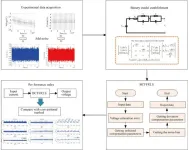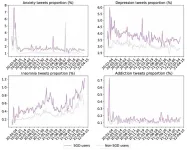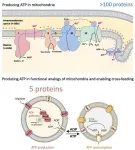(Press-News.org)
For the main energy storage system for EVs, Li-ion batteries are extensively applied owing to their excellent overall performance The safe and efficient operation of the electric vehicle significantly depends on the accurate state-of-charge (SOC) and state-of-temperature (SOT) of Lithium-ion (Li-ion) batteries. A recent breakthrough study presented by researchers from the Tongji University and Chongqing University introduces a co-estimation of state-of-charge and state-of-temperature for large-format lithium-ion batteries based on a novel electrothermal model. This advanced method will accurately estimate soc battery SOC and SOT to avoid overcharging and over-discharging, as well as thermal hazards
The study focuses on the co-estimation of battery SOC and temperature distribution for large-format Li-ion batteries. As a complex electrochemical system, the Li-ion batteries show an evident coupling relationship between SOC and SOT. Specifically, the battery temperature evolution directly affects battery capacity, OCV, Ohmic and polarization resistances, and so forth, thereby affecting the SOC estimation accuracy. Similarly, the prediction performance of battery SOT also strongly depends on SOC. A co-estimation framework of SOC and SOH, at the heart of this research, is based on an innovative electrothermal model and adaptive estimation algorithms. This method takes into account the response between battery states, making up for the greater bias that would result from separately estimating battery SOC and SOT.
Key to the algorithm's success is its ability to the control-oriented electrothermal model—a first-order RC electric model and an innovative thermal model. Specifically, the thermal model includes two lumped-mass thermal submodels for two tabs and a two-dimensional (2-D) thermal resistance network (TRN) submodel for the main battery body. And the adaptive estimation algorithms are composed of an adaptive unscented Kalman filter (AUKF) and an adaptive Kalman filter (AKF), which adaptively update the state and noise covariances. Regarding the estimation results, the mean absolute errors (MAEs) of SOC and SOT estimation are controlled within 1% and 0.4 C at two temperatures, indicating that the co-estimation method yields superior prediction performance in a wide temperature range of 5–35 C.
The thermal model is capable of capturing the detailed thermodynamics of large-format Li-ion batteries. To comprehensively investigate the thermal characteristics of the battery during its operation and acquire a representative temperature dataset, five typical temperature measurement points are preset on the surface of the battery. The electric and thermal models are coupled by utilizing the battery temperature dependence of the electrical model parameters.
By monitoring both temperature and charge state, the research can effectively prevent risks such as thermal runaway, reducing the chances of battery fires or explosions and improving overall vehicle safety. Moreover, the study can help avoid battery failure in extreme conditions, enhancing the stability and reliability of the entire energy storage system.
In conclusion, this innovative approach can accurately and efficiently monitor two critical states of the Li-ion battery-SOC and SOT. It can not only meet the functions of the battery management system, but also help further promote carbon neutrality. As research progresses, further research can provide more input and improvements, and accurate real-time online applications of SOCs and SOTs are not out of reach.
Reference
[1] Hu XS, Feng F, Liu KL, Zhang L, Xie JL, Liu B. State estimation for advanced battery management: key challenges and future trends. Renewable Sustainable Energy Rev Oct 2019;114:109334.
[2] Chen C, Xiong R, Yang R, Li H. A novel data-driven method for mining battery open-circuit voltage characterization. Green Energy Intell Transp 2022;1(1):100001. 06/01/2022.
[3] He HW, Xiong R, Zhang XW, Sun FC, Fan JX. State-of-Charge estimation of the lithium-ion battery using an adaptive extended Kalman filter based on an improved Thevenin model. IEEE Trans Veh Technol May 2011;60(4):1461–9.
[4] Ng KS, Moo CS, Chen YP, Hsieh YC. Enhanced coulomb counting method for estimating state-of-charge and state-of-health of lithium-ion batteries. Appl Energy Sep 2009;86(9):1506–11.
Author: Chao Yu, Jiangong Zhu, Wenxue Liu, Haifeng Dai, Xuezhe Wei
Title of original paper: Co-estimation of state-of-charge and state-of-temperature for large-format lithium-ion batteries based on a novel electrothermal model
Article link: https://doi.org/10.1016/j.geits.2024.100152
Journal: Green Energy and Intelligent Transportation
https://www.sciencedirect.com/science/article/pii/S2773153724000045
END
Lithium-ion power battery technology stands out as a pivotal component in advancement of new energy electric vehicles (EVs). Battery parameter identification, as one of the core technologies to achieve an efficient battery management system (BMS), is the key to predicting and managing the performance of Li-ion batteries. A recent breakthrough study presented by researchers from Hebei University of Technology proposes an online battery model parameters identification approach based on bias-compensated forgetting factor recursive least squares. This advanced method is expected to improve the accuracy of parameter identification under different noise.
The ...
Over four hundred people, 80% of them being children under 14 years old, will be diagnosed with B-cell Acute Lymphoblastic Leukaemia (B-ALL) next year in Spain, according to the latest projections from the Spanish network of cancer registries (REDECAN). Survival rates for this rapid-growing and aggressive type of blood cancer are high in youth, but fall rapidly with age, especially after 40, stressing the need for new therapeutic alternatives.
B-ALL arises when B-lymphocytes - the antibody producing cells of the immune system - fail to properly mature in the bone marrow, leading to the accumulation of immature progenitors ...
A new study by researchers at Zhejiang University has highlighted the disproportionate health challenges faced by sexual and gender-diverse (SGD) individuals during the COVID-19 pandemic. By analyzing over 471 million tweets using advanced natural language processing (NLP) techniques, the study reveals that SGD individuals were more likely to discuss concerns related to social connections, mask-wearing, and experienced higher rates of COVID-19 symptoms and mental health issues than non-SGD individuals. The study has been published in the journal Health Data ...
A new study1 has unveiled the Hispanic Thrifty Food Plan (H-TFP), a culturally adapted and affordable diet specifically designed to align with the eating habits of U.S. Hispanic households. The research, led by Adam Drewnowski, PhD, from the University of Washington, used advanced dietary modeling to create a version of the USDA’s Thrifty Food Plan (TFP) that respects the distinctive food patterns of Hispanic communities.
The USDA's Thrifty Food Plan is the foundation for setting benefits under the Supplemental Nutrition Assistance Program (SNAP), but it has not traditionally accounted for the ...
An innovative study, to be published in Nature Communications on October 21, 2024, reveals the mechanism behind two seemingly contradictory effects of fear memories: the inability to forget yet the difficulty to recall. Led by researchers from Sony Computer Science Laboratories, Inc., ATR Computational Neuroscience Laboratories, and the University of Tokyo, the study shows how fear experiences are initially remembered as broad, associative memories, but over time become integrated into episodic memories with a more specific timeline.
The researchers conducted experiments using functional ...
Guideline Highlights:
Each year in the U.S., over half a million people have a first stroke; however, up to 80% of strokes may be preventable.
The new primary prevention of stroke guideline from the American Stroke Association urges health care professionals to screen people for stroke risk factors, including high blood pressure, elevated cholesterol, high blood sugar and obesity.
Increasing public awareness and knowledge about healthy lifestyle changes, such as smoking cessation, increased physical activity, improved dietary habits and better sleep, may also help people reduce their stroke risk.
The new guideline highlights the American Heart ...
It is one of the most fundamental questions in science: how can lifeless molecules come together to form a living cell? Bert Poolman, Professor of Biochemistry at the University of Groningen, has been working on this problem for over twenty years. He aims to understand life by trying to reconstruct it; he is building simplified artificial versions of biological systems that can be used as components for a synthetic cell. Poolman recently published two papers in Nature Nanotechnology and Nature Communications. In the first paper, he describes a system for energy conversion ...
In one of the largest-ever studies of DNA and brain volume, researchers have identified 254 genetic variants that shape key structures in the “deep brain,” including those that control memory, motor skills, addictive behaviors and more. The findings were just published in the journal Nature Genetics.
The study is powered by the Enhancing Neuro Imaging Genetics through Meta-Analysis (ENIGMA) consortium, an international effort based at the Keck School of Medicine of USC, which unites more than 1,000 research labs across 45 countries to hunt for genetic variations that affect the brain’s structure and function.
“A lot of brain diseases are known to be partially ...
Food production is one of the pillars of human civilization and underlies many of the changes caused by humans on planet’s landscapes. Producing food and getting it to people’s plates entails a significant expenditure of energy and resources. Unfortunately, approximately one third of all food produced globally is not consumed and discarded. Hence, to build sustainable societies, it is essential to minimize food waste.
In Japan, based on estimates reported by governmental institutions, an astonishing 2.47 megatons of food waste was generated in ...
Many women who receive chemotherapy experience a decreased ability to remember, concentrate, and/or think—commonly referred to as “chemo-brain” or “brain fog”—both short- and long-term. In a recent clinical trial of women initiating chemotherapy for breast cancer, those who simultaneously started an aerobic exercise program self-reported greater improvements in cognitive function and quality of life compared with those receiving standard care. The findings are published by Wiley online in CANCER, a peer-reviewed journal of the American Cancer Society.
The study, called the Aerobic exercise and ...






